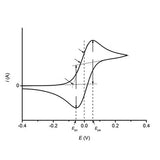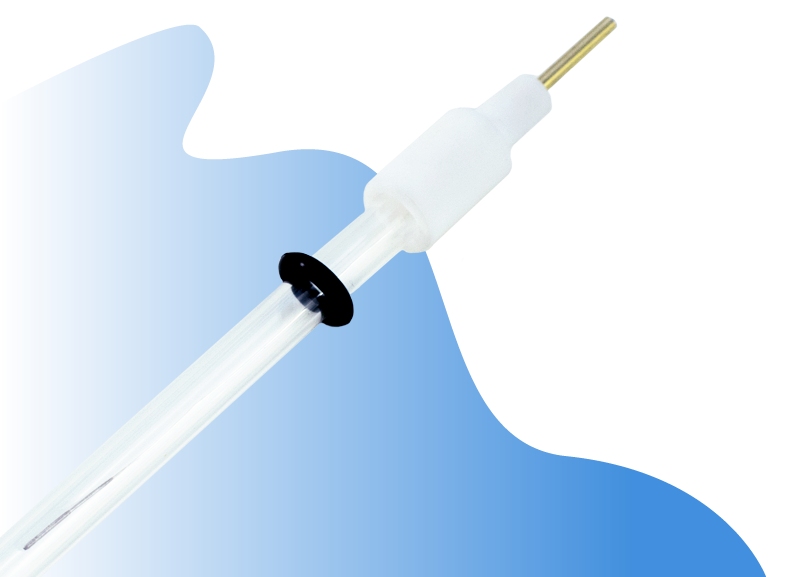Spectroelectrochemistry

Spectroelectrochemistry (SEC) refers to a range of experimental techniques that combine electrochemistry and spectroscopy using a potentiostat and spectrometer. While electrochemical experiments provide information on macroscopic properties, spectroscopic techniques give information on a molecular level. The combination of the two therefore provides a comprehensive picture of a given material [1].
In spectroelectrochemistry, the spectroscopic response is typically observed in situ and the electrochemical reaction is carried out under controlled conditions [5].
The design of spectroelectrochemical cells is usually determined by the requirements of the spectrometer. The electrochemical cell and electrodes must be transparent enough to observe the analyte, as must the electrolytes. However, even when using photoelectrochemical cells, measurements in the UV and IR regions are often limited by the optical absorption properties of the cell windows or electrolyte components (e.g. the solvent and conducting salt). In particular, the strong absorption bands that are exhibited by many solvents will limit their use in the infrared region.
Comparatively, it is relatively straightforward choose which solvent to use when you are taking UV-vis measurements with a spectromter (such as a USB spectrometer). Most solvents commonly used in standard electrochemistry are suitable.
Spectroelectrochemical techniques can generally be classified based on the type of spectroscopy (UV-vis, NIR or IR, Raman spectroscopy, EPR, NMR, XAS, or luminescence) or the electrochemical method (chronopotentiometry, chronoamperometry, linear sweep voltammetry, cyclic voltammetry, differential pulse voltammetry, stripping voltammetry, or pulse techniques). In practice, it is more common for spectroelectrochemical techniques to be classified according to their spectroscopic methods [6] than their electrochemical methods.
Response times
For a single electron wave, spectroelectrochemistry cells have response times that range from 10 seconds to several minutes. This is a bit longer than the typical sweep rate in cyclic voltammetry (CV) which is about 100 mVs-1. Therefore, reactions labelled as fully reversible by cyclic voltammetry will become less reversible. This is due to the slow reaction of the electrogenerated products.

UV-Vis Absorption Spectroelectrochemistry
UV-vis spectroelectrochemistry (UV-vis-SEC) can be used to probe the electronic transitions of molecules that absorb light in the ultraviolet and visible regions of the electromagnetic spectrum [7]. Both the wavelengths at which absorption occurs, and the degree of this absorption are measured by an optical spectrometer. The spectrum is then presented as a graph of either absorbance versus wavelength, or absorbance versus time. Based on the applied electrode potential, the resulting spectrum shows only the absorptions caused by the electrochemically generated species [7].
With optically transparent electrodes, UV-vis spectroelectrochemistry can study molecular adsorbates, polymer films, or other modifying layers that are either attached to the electrode surface, or in the phase adjacent to it.
Photoluminescence Spectroelectrochemistry
Spectroelectrochemical methods can be used to spectroscopically detect the unique chemical species generated in situ at electrode surfaces during redox reactions. Photoluminescence spectroelectrochemistry (PL-SEC) uses photoluminescence in combination with electrochemistry to selectively investigate the excited state properties of in situ generated chromophores [8].
With photoluminescence spectroelectrochemistry, the properties of new excited state species can be investigated along with their reactivity.
One example of this is the Re(II) complex, [Re(dmpe)3]2+, where dmpe is 1,2-bis(dimethylphosphino)ethane. The parent Re(I) complex, [Re(dmpe)3]+, is readily synthesised and exhibits a reversible one-electron oxidation to Re(II) in acetonitrile. The d6 Re(I) form is colourless and, upon excitation into the UV absorption band, exhibits no luminescence. By contrast, oxidation in the luminescence spectroelectrochemical cell to the d5 Re(II) electron configuration gives a reddish-pink solution with an absorption maximum at 530nm. This is accruable to a ligand-to-metal charge-transfer (LMCT) band. Excitation at 530nm produces a strong emission at 593nm with a quantum efficiency of 0.066, significantly higher than that of the standard typically used for comparison, i.e., [Ru(bpy)3]2+ in water, which is 0.042 [8].
USB Spectrometer

Infrared Spectroelectrochemistry
Infrared spectroelectrochemistry (IR-SEC) has been used to investigate adsorption phenomena in electrochemical systems as well as to identify and unravel molecular mechanisms of biological electron transfer. It has applications in the study of conducting polymers, redox-active organic molecules in solution, inorganic or organometallic complexes, as well as being often used in mechanistic studies and electrocatalysis.
It is becoming increasingly common to combine IR-SEC with other physical techniques. An example of this would be to scan electrochemical microscopy [9], and thus, gain a more complete analysis of the sample.
Raman Spectroelectrochemistry
In Raman spectroelectrochemistry (Rama SEC), vibrational information is used to gauge the strength of chemical bonds within molecules, between molecules, and at electrode surfaces.
Raman spectroelectrochemistry is often the method of choice for analysing the structure of materials. It can be used for 2D materials (including carbon materials such as graphite or graphene), nanostructures such as carbon nanotubes, and fullerenes. It can also be used to probe information about crystalline or amorphous structures, and you can obtain crystallite size from the shift and shape of vibration modes. In battery research, Raman SEC can be used to determine the state and quality of nanostructured battery materials and lithium content.
If you are analysing self-assembled monolayers, you can use Raman spectroelectrochemistry to obtain information on the orientation of molecules on the surface of electrodes [10].
Potentiostat

X-Ray Spectroelectrochemistry
You can use X-ray spectroelectrochemistry (X-ray SEC) to provide information about the basic considerations and symmetry of the electronic structure of active atomic orbitals of different materials. For example, you can use it to determine bond lengths and angles, the identities of neighbouring atoms, and oxidation states [6]. X-ray SEC is also useful for spectroelectrochemical studies on corrosion processes, electrodeposition, ionic adsorption, and yields of fuel cell anodes [6].
Nuclear Magnetic Resonance Spectroelectrochemistry
Nuclear magnetic resonance spectroelectrochemistry (NMR-SEC) provides an interesting approach for monitoring and understanding electrochemical and electrocatalysis processes at a molecular level.
Examples of measurements you can perform using NMR-SEC include, the redox behaviour of quinone-based systems [11], the electrooxidation of dopamine at various voltages, PH levels when using Au nanoparticles modified electrode [12], and the electrocatalysis of hydroquinone by nano-polyaniline (nano-PAn) films [13].
Electron Paramagnetic Resonance Spectroelectrochemistry
Electron spin/paramagnetic resonance spectroelectrochemistry (ESP/EPR-SEC) can be used to detect short-lived radicals. You can use ESP/EPR to provide valuable information about the oxidation state of an atom or atoms within a (macro) molecule by using impaired electrons as probes. You can also use it to understand the environment of these atoms. Because of this, ESP/EPR-SEC can be used to investigate paramagnetic species such as organic radicals, proteins, polymers, and transition-metal complexes [14].
In-situ, ESR/EPR spectroscopy can also be combined with UV-vis spectroscopy.
Learn More
 Potentiostat Working Principles and Fundamentals
Potentiostat Working Principles and Fundamentals
Potentiostats are voltage sources that vary their output potential in response to changes in the resistance across the circuit.
Read more... Cyclic Voltammetry Basics, Setup, and Applications
Cyclic Voltammetry Basics, Setup, and Applications
Cyclic voltammetry is an electrochemical technique for measuring the current response of a redox active solution to a linearly cycled potential sweep between two or more set values.
Read more...References
- W. Plieth, G.S. Wilson, C. Guiterrez de la Fe, Spectroelectrochemistry: A Survey of In-situ Spectroscopic Techniques, Pure and Applied Chemistry, 1998, 70, 1395-1414. https://www.iupac.org/publications/pac/pdf/1998/pdf/7007x1395.pdf.
- R. Holze, Surface and interface analysis. In: Springer series in chemical physics, 2009, vol 74. Springer, Berlin/Heidelberg.
- W. Kaim and J. Fiedler, (2009) Spectroelectrochemistry: the best of two worlds. J Chemical Society Reviews, 2009, 38, 3373-3382. https://doi.org/10.1039/B504286K.
Related Products


